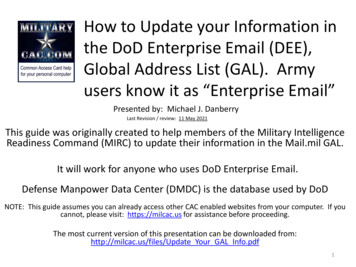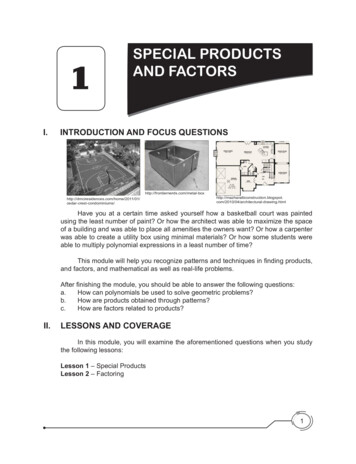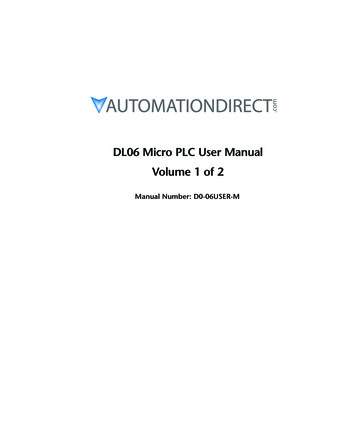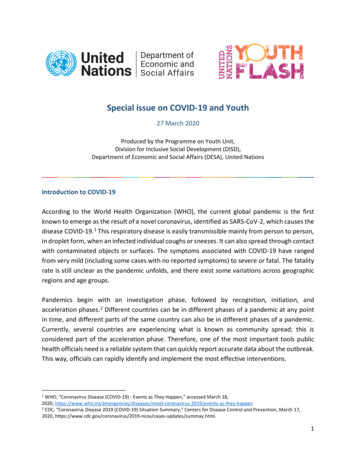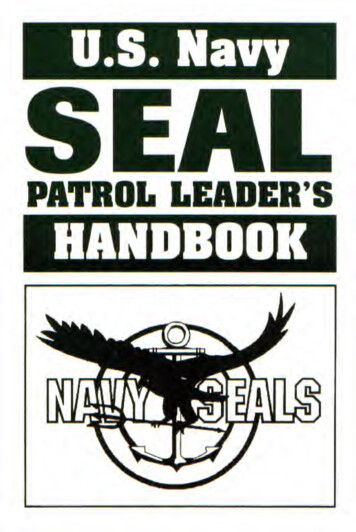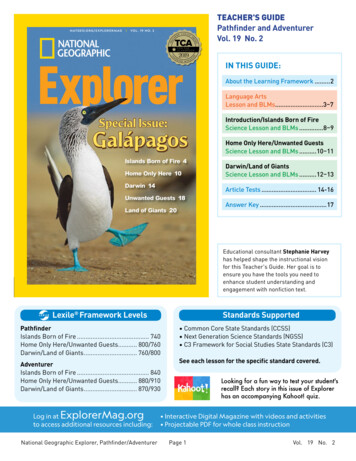
Transcription
N ATG E O.O RG/ E X P LO R E R M AG VO L . 1 9 N O. 2ERHOICS’ CESMADTEARACWHTEACHER'S GUIDEPathfinder and AdventurerVol. 19 No. 2ENING MAGNL2019REFOR THECLASSROOMAAZI IN THIS GUIDE:About the Learning Framework 2Language ArtsLesson and BLMs.3–7Introduction/Islands Born of FireScience Lesson and BLMs.8–9Special Issue:Galápagosuringmber–Home Only Here/Unwanted GuestsScience Lesson and BLMs.10–11Islands Born of Fire 47ther:Darwin/Land of GiantsScience Lesson and BLMs.12–13Home Only Here 1091875,ates.Darwin 14Article Tests. 14-16Unwanted Guests 18Answer Key.17Land of Giants 20NATUREPL.SUPERSTOCK;UPWELLINGMAURICIOTO;OOK ANDEducational consultant Stephanie Harveyhas helped shape the instructional visionfor this Teacher's Guide. Her goal is toensure you have the tools you need toenhance student understanding andengagement with nonfiction text.TO; PAGES& BEAKS)ND OF GIANTSGIANTS:(BIG PHOTO)TOISEFinal AD Oct 2019.indd 16/14/19 11:18 AMLexile Framework LevelsStandards Supported PathfinderIslands Born of Fire 740Home Only Here/Unwanted Guests. 800/760Darwin/Land of Giants 760/800AdventurerIslands Born of Fire 840Home Only Here/Unwanted Guests. 880/910Darwin/Land of Giants 870/930ExplorerMag.orgLog in atto access additional resources including:National Geographic Explorer, Pathfinder/Adventurer Common Core State Standards (CCSS) Next Generation Science Standards (NGSS) C3 Framework for Social Studies State Standards (C3)See each lesson for the specific standard covered.Looking for a fun way to test your student'srecall? Each story in this issue of Explorerhas an accompanying Kahoot! quiz. Interactive Digital Magazine with videos and activities Projectable PDF for whole class instructionPage 1Vol. 19 No. 2
National Geographic Learning FrameworkINTRODUCTIONBACKGROUNDSince 1888, the NationalGeographic Society has fundedscientists and explorers andshared their findings with theworld. To support educatorswho use our resources, we havecreated a Learning Framework,which lays out what we believestudents should learn from theirexperiences with the Society.PURPOSEThe Learning Framework wasdesigned to convey the Society'score beliefs and values. It is builtaround a set of attitudes, skills,and knowledge that embody theexplorer mindset.To determine the learningoutcomes within the LearningFramework, we dug deepinto national standards in keysubject areas. We also soughtadvice from subject matter andchild development experts,along with the combinedexpertise of NG instructionaldesigners, researchers, andcontent developers. To learnmore, go to: ingframework/.IMPLEMENTATIONEach article in this magazine hasa knowledge-based link to theLearning Framework.MINDSET OF AN EXPLORER: KEY FOCUS AREASAAttitudesCURIOSITY An explorer remains curious about how the worldworks throughout his or her life. An explorer is adventurous, seekingout new and challenging experiences.RESPONSIBILITY An explorer has concern for the welfare of otherpeople, cultural resources, and the natural world. An explorer isrespectful, considers multiple perspectives, and honors othersregardless of differences.EMPOWERMENT An explorer acts on curiosity, respect, responsibility,and adventurousness and persists in the face of challenges.SSkillsOBSERVATION An explorer notices and documents the worldaround her or him and is able to make sense of those observations.COMMUNICATION An explorer is a storyteller, communicating experiencesand ideas effectively through language and media. An explorer has literacyskills, interpreting and creating new understanding from spoken language,writing, and a wide variety of visual and audio media.COLLABORATION An explorer works effectively with others to achieve goals.PROBLEM SOLVING An explorer is able to generate, evaluate,and implement solutions to problems. An explorer is a capabledecisionmaker—able to identify alternatives and weigh trade-offs tomake a well-reasoned decision.KnowledgeKTHE HUMAN JOURNEY An explorer understands where we camefrom, how we live today, and where we may find ourselves tomorrow.OUR CHANGING PLANET An explorer understands the amazing,intricate, and interconnected systems of the changing planet we live on.WILDLIFE AND WILD PLACES An explorer reveals, celebrates, and helpsto protect the amazing and diverse creatures we share our world with.National Geographic Explorer, Pathfinder/AdventurerPage 2Vol. 19 No. 2
LANGUAGE ARTS Use Images and Text to Make MeaningStandards Supported CCSS Reading Informational Text: Interpret informationpresented visually, orally, or quantitatively (e.g., in charts, graphs,diagrams, time lines, animations, or interactive elements onWeb pages) and explain how the information contributes to anunderstanding of the text in which it appears. (4-7)What You'll Need “The Galápagos Islands” (Explorer, pages 2–3 “Islands Born of Fire” (Explorer, pages 4–9) Think Sheet (Teacher’s Guide, page 5) Clipboards P encilsCONNECT & ENGAGE (20 minutes)MODEL (10 minutes)Kids are in a group with you in front of them. Holdup pages 2–3 in the magazine.Kids remain in a group with you in front of them.TEACHER TIP: Use the first two pages of Explorerfor Connect & Engage. This will set the stage forthe remaining articles in the magazine. The rest ofthis Language Arts lesson will focus on the article“Islands Born of Fire.”Say: Before we move on, did you notice the smallworld map in the upper corner of the map of theislands? What did that help you do?Kids should note that the locator map shows exactlywhere in the world the islands are.Say: Today we are going to be reading about theGalápagos Islands. We are going to use the pictures,maps, and diagrams to help us understand moreabout these unique and interesting islands. To get usstarted, I’m going to read aloud the text on page 3.It’s an introduction from the managing editor of themagazine.Say: A map like this is sometimes called a locatormap. It helps you find exactly where a place is locatedin the world.Read aloud the text on page 3.Read aloud the first paragraph on page 4.Say: Now take a look at the map of the islands onpages 2–3. Can anyone remind us what kind ofinformation a map can give us?Say: Do you feel like you know where the islandsare now? How does having a map to look at help youunderstand? How did the text also help? Turn and talkabout that.Kids should share that a map can provide us lotsof information about a place, such as location,shape of the land, and in this case the names of thevarious islands.Say: Take some time to look carefully at the map, andthen turn and talk about what you notice.Kids turn and talk about the map. They shouldmention things such as the number of islandson the map, the different sizes and shapes of theislands, the names in both Spanish and English,and where the islands are located. They may alsomention the map scale and the compass rose,which give information that helps us understandposition and scale on the map.National Geographic Explorer, Pathfinder/AdventurerSay: I’m going to read the first paragraph on page 4.It tells how to find the islands. As I’m reading, look atthe locator map on page 3 as well as the big map ofthe islands on pages 2–3.Kids turn and talk.Say: This is important stuff to keep track of, if wewant to use everything in the article to help us makemeaning out of what we are viewing and reading. I’mgoing to use this Think Sheet chart to write down howthe map and the text help me understand.Show kids the three-column Think Sheet chart. Inthe Image column, write “map”; in the Text column,write “first paragraph on page 4”; and in the HowThey Help Me Understand column, write “They helpme figure out where the islands are located.”Page 3Vol. 19 No. 2
LANGUAGE ARTS Use Images and Text to Make MeaningGUIDE (10 minutes)Hand out Think Sheets and have kids attach themto their clipboards. Kids remain in a group with youin front of them.Say: I’m going to read aloud the rest of the text onpages 4–5. Then we’ll look at the images together.Read aloud the text on pages 4–5.Say: Okay, the text tells us how a hot spot, volcanoes,and tectonic plates were involved in the formation ofthe islands. The diagrams and photos on these pageshelp us view more about this process. Let’s take acloser look at those images.Look at and talk through each of the images in thediagram. Read the captions and check to see if kidshave questions about what they are viewing. Thenlook at the photos and caption on the pages. Makesure kids know that the diagram has illustrationsof the process, and the photos are real images ofsome parts of the islands.Say: Now turn and talk about the text and the imageswith your partner and write your thoughts on yourThink Sheet.Kids should write something like the following ontheir Think Sheet for the diagram and the text onpages 4–5.Image: diagram at the bottom of pages 4–5Text: information about hot spot, volcanoes, andtectonic platesHow They Help Me Understand: I can read and seehow the islands formed and moved.COLLABORATE (25 minutes)the text and the images on your Think Sheet. Anddon’t forget to write how they help you understand.Partners read the rest of the article together,stopping to write their thoughts on the Think Sheet.Move around the room, conferring with partners.For pages 6–7: From the text, make sure kidsunderstand ways in which the islands are uniquefrom one another. They should also note thebiodiversity on the islands and how and why thathappened. The images show a few examples of lifeon the islands.For pages 8–9: On these pages, both the text andthe diagram help kids understand the currentsand upwelling in this area, as well as how theyare connected to the abundance of wildlife on theislands.SHARE THE LEARNING (10 minutes)Kids join a sharing circle with you and share out,using respectful language.Say: Okay, now it’s time to share your new learning.Choose an example from your Think Sheet to sharehow images and text helped you understand. I amgoing to invite [student name] to share. We are goingto share using respectful language. So when I ask:“[student name] would you like to share your newlearning?” You can say: “Yes, thank you.” Then you canshare your example. After you share, you can invitesomeone else to share. To do that, you need to call onthe person by name and use the same language wejust practiced. When we use polite, respectful sharinglanguage, everyone pays closer attention to theimportant information being shared.TEACHER TIP: There are several more pages toread in the article. Have kids partner up to worktogether to read the rest of the article. Somepartners may need more assistance than others.Walk around the room to gauge how each pair isdoing, and offer help as needed.Kids share out and invite others to share, alwaysusing the respectful sharing language that wasmodeled. There should be time for about 3 or 4kids to share out with the whole group. Once theyare finished, have everyone turn and share with theperson next to them, so that all have a chance to beheard.Say: Now it’s time for you to read with a partner. Gothrough the rest of the article together, using theimages and text to make meaning. As you are viewingand reading, stop to write down your thoughts aboutWe learned so much today about using the textand many different kinds of images, such as maps,diagrams, and photos to help us understand and makemeaning as we read. What a great job you all did!National Geographic Explorer, Pathfinder/AdventurerPage 4Vol. 19 No. 2
NameDateTHINK SHEETWrite the nonfiction features and their purpose.TEXTHOW THEY HELP MEUNDERSTAND 2019 National Geographic Society. All rights reserved. Teachers may copy this page to distribute to their students.IMAGENational Geographic Explorer, Pathfinder/AdventurerPage 5Vol. 19 No. 2
LESSON FRAME Use Images and Text to Make MeaningWhat You'll Need Nonfiction text Think Sheet template Clipboards and pencilsThis frame is a kind of template of thelesson we just worked on. It has theinstructional moves and language ofthe lesson, but the specific content hasbeen removed. This way you can use theLesson Frame for the other articles in theissue or for any nonfiction text you mightbe teaching.CONNECT & ENGAGE (5 minutes)Kids are in a group with you in front of them. Holdup the article.Say: Today we are going to be reading about. We are going to use the images and thetext to help us understand more about .To get us started, I’m going to read aloud the text onpage .Read aloud the text on page .Say: Now take a look at the image(s) [could be photo,map, diagram, etc.].Say: Take some time to look carefully at the image(s),and then turn and talk about what you notice.Kids turn and talk about what they notice.MODEL (10 minutes)Kids remain in a group with you in front of them.Say: Now I’m going to continue reading aloud. Listenas I read, and look at the image(s) on the page(s).Read aloud page(s) .National Geographic Explorer, Pathfinder/AdventurerSay: What did you notice about the image(s), and howdid that help you understand what you were hearingas I read the text? Turn and talk about that with apartner.Kids turn and talk.Say: This is important stuff to keep track of, if wewant to use everything in the article to help us makemeaning out of what we are viewing and reading. I’mgoing to use this Think Sheet chart to write down howthe image(s) and the text help me understand.Show kids the three-column Think Sheet chart.Write your thoughts in the Image column, the Textcolumn, and the How They Help Me Understandcolumn. Think aloud as you are writing to model forkids how you used the image(s) and text
Say: A map like this is sometimes called a locator map. It helps you find exactly where a place is located in the world. Say: I’m going to read the first paragraph on page 4. It tells how to find the islands. As I’m reading, look at the locator map on page 3 as well as the big map of the islands on pages 2–3.



